#forest products manufacturers
Text
What Is The Size Of The Forest Products Industry In India?
The forest products industry in India is diverse and plays a crucial role in the country's economy. Numerous manufacturers are producing a wide range of products derived from forest resources.
The forest products industry involves the production of goods and services derived from forest resources. And this crucial sector includes both timber and non-timber products. This industry plays an important role in the growth and development of the economy as it has a significant impact on rural communities and the environment.
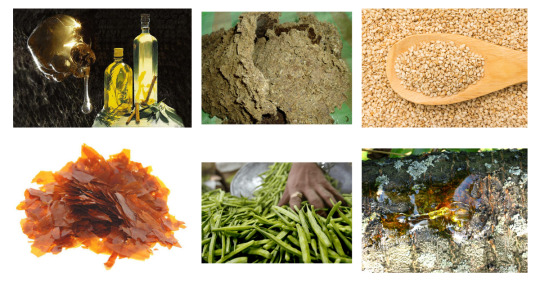
Classification Of Forest Produce
1. Timber products
This includes sawn timber, plywood, veneers, and other wood-based products derived from forests. These products have wide applications in construction, furniture, and interior design manufacturing
2. Paper products
Paper is needed for the publishing industry and includes newsprint, printing paper, tissue paper, packaging, and other products made from wood pulp. These products have wide applications in both residential and commercial sectors.
3. Non-timber forest products (NTFPs)
It includes a wide range of products derived from forest resources other than timber. Examples include rubber, resin, honey, nuts, mushrooms, and medicinal plants. There could be more products available depending on location and environment.
Bioenergy: Forests are a crucial source of bioenergy, including wood pellets, chips, and other biomass products used to generate electricity, heat buildings, and fuel vehicles.
India has a diverse range of forests that are home to a variety of tree species, many of which are used for different forest products. Some of the important forest products in India include the following:
Timber: India has several timber species that are used for furniture, construction, and other purposes. Some popular timber species include teak, rosewood, sal, deodar, sandalwood, and bamboo. The country has vast reserves of forests that provide quality timber.
Medicinal plants: India has a rich tradition of using medicinal plants for healthcare. Many of these plants are found in the forests and are used to produce medicines, herbal teas, and other health products. In addition, they are used to flavor cosmetics and health foods as nutritional supplements.
Non-timber forest products (NTFPs): NTFPs are products that are derived from forest resources other than timber. Some examples of NTFPs in India include honey, beeswax, bamboo shoots, mushrooms, and various spices. These products are in great demand in both domestic and global markets.
Paper: India has a large paper industry that relies on wood pulp for paper production. The country has several paper mills that use different types of wood for paper production. It has a significant contribution to the country's economy.
Rubber: India is one of the major producers of natural rubber, which is extracted from rubber trees found in forest areas. Rubber is used for various purposes in different industries.
Fruits and nuts: Many forest areas in India are home to mixed fruit and nut trees such as mango, jackfruit, cashew, and walnut. These products have generated huge demand in both domestic and global markets.
Lac: Lac is a resinous substance secreted by an insect and used in the production of shellac, which is used in making varnish, wax, and other products. India is one of the major producers of lac in the world. Also, the country has initiated a special program to promote lac farming.

Government Initiative
The government formed Shellac Export Promotion Council (SEPC) in 1956 to promote the export of shellac and shellac-based products. Shellac is a resinous substance that is secreted by the female lac bug and is used in the production of various products, including varnishes, food glazes, and pharmaceuticals.
The SEPC is responsible for promoting the export of shellac and shellac-based products and providing support to shellac manufacturers and exporters. The council works closely with government agencies, industry associations, and other stakeholders to promote the use of shellac in various industries and to increase its export potential.
The Shellac Export Promotion Council works to create awareness about Indian shellac and forest products in the international market by organizing trade fairs, buyer-seller meets, and exhibitions. It also provides various kinds of assistance to exporters, such as information on market trends, opportunities, and regulatory requirements.
The SEPC is crucial in promoting and supporting the export of shellac and other forest products from India. Its various activities and initiatives help to increase the demand for Indian products and enhance the competitiveness of Indian exporters in the international market.
India has a thriving forest sector, with numerous manufacturers producing various products derived from forest resources. Some of the big forest products manufacturers in India include:
Greenply Industries: Greenply is one of the largest producers of plywood and other wood-based products in India. The company operates several manufacturing facilities across the country and offers a range of products, including plywood, veneers, and laminates.
Century Plyboards: Century Plyboards is another major player in the Indian Plywood industry, producing a wide range of plywood, veneers, and laminates. The company also operates a manufacturing facility that produces particleboard and MDF.
Dabur India: Dabur is a well-known Indian company that produces a range of ayurvedic and herbal products, including those derived from forest resources. The company is a major producer of honey, which is sourced from forest areas.
TTK Prestige: TTK Prestige is a manufacturer of kitchen appliances, including cookware and other products made from non-timber forest products like bamboo. The company sources bamboo from sustainable plantations and supports local communities through its operations.
Godrej and Boyce: Godrej and Boyce is a diversified company with operations in various sectors, including forest goods. The company produces a wide range of furniture, including those made from timber and other materials.
Cello Industries: Cello Industries is a manufacturer of plastic and composite products, including those made from bamboo composite. One of the most important forest-based industries, the company sources bamboo from sustainable plantations and produces a range of products, including furniture, flooring, and other items.
#forest-based industries#forest#forest products#forest products manufacturers#forest products industry#forest products in India#Indian forest
0 notes
Text
USAmericans
Read the Project 2025 manifesto RIGHT NOW
It's MUCH worse than y'all have been hearing
There is so much here you'll have to look at it for yourself, but the climate policy alone is nightmare fuel.
The republican coalition wants to essentially end funding for green energy, dramatically promote and expand fossil fuel industries, and eliminate funding and regulations in all sectors promoting climate change mitigation. Task forces and offices related to clean energy and lowering carbon emissions will be eliminated and replaced with offices for promoting fossil fuels.
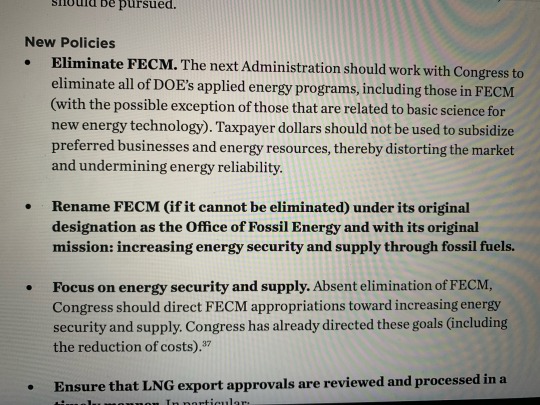
They want to LOG NATIONAL FORESTS TO "THIN" THE TREES TO STOP WILDFIRES.
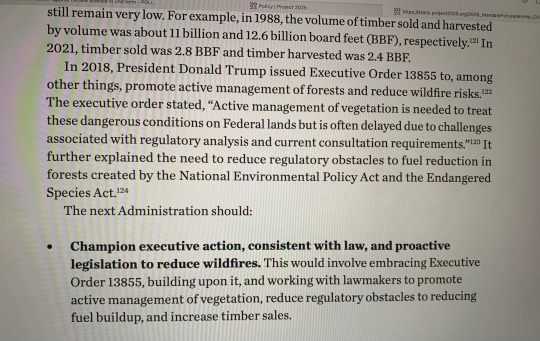
THEY WANT TO FORCE OREGON AND CALIFORNIA TO LOG THEIR NATIONAL FORESTS AND TREAT THEM AS FOR TIMBER PRODUCTION

There are specific provisions in Project 2025 to essentially destroy the Endangered Species Act, causing it to defer to the rights of "economic development" and "private property." The plan includes delisting gray wolves, cutting the budget so that a "triage" system is used to determine which species will get protection, removing funding for research, removing experts and specialists from the decision-making process, and preventing "experimental" populations of animals from being established.
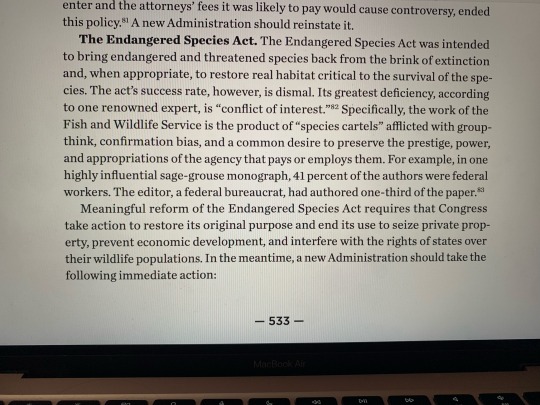


This is so much worse than I expected it to be and there's much more past that: They want to deregulate pesticides and remove much of the EPA's ability to regulate pollutants as well.
Also included in the manifesto is that we should
withdraw from nuclear weapons nonproliferation agreements, build more nuclear weapons, and resume nuclear weapons testing

The manifesto comprehensively outlines the scorched-earth elimination of abortion access, down to ensuring doctors aren't even trained to perform abortions. There are plans in here to disrupt abortion access GLOBALLY, not just domestically.
Not only that,the Republicans plan on reframing family planning programs around "fertility awareness" and "holistic family planning."

I can't even describe it all. I'm trying to give screenshots of the most important things but there's so much.
The foreign policy is a nightmare. They plan to push fossil fuels onto the Global South and promote the development of fossil fuel industry in the "developing world."
It is aggressive and antagonistic towards other nations, strongly pro-military, proposing that we INCREASE (!!!!!) defense spending, improve public opinion of the military and military recruitment, and increase the power to fund new weapons technology.
Just read the Department of Defense section. It's about greatly increasing and strengthening the military-industrial complex, collaborating more closely with weapons manufacturers, removing regulatory barriers to arming our allies and to inventing new military weapons, and recruiting more people into the military. They include provisions to develop AI technology for surveillance. And of course, continuing to support Israel is in there.
Elsewhere it proposes interfering in foreign countries with creepy pro-USA propaganda campaigns, even establishing international educational programs where faculty have to pledge to promote USA interests.
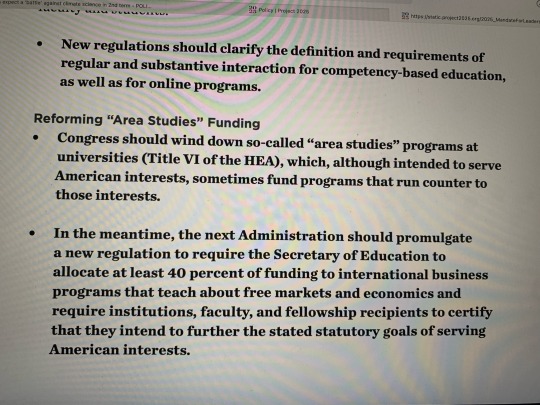
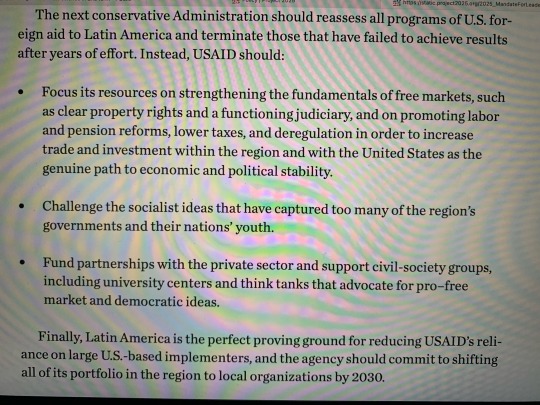
There's a line in here about getting rid of PBS because SESAME STREET is LEFTIST for God's sake.
HOW are people claiming democrats have the same policies. I feel like i'm losing my mind.
16K notes
·
View notes
Text
this house may or may not be real
on grayness in real estate
Allegedly, somewhere in Wake Forest, North Carolina, a 4 bed, 5.5 bathroom house totaling more than 6,600 square feet is for sale at a price of 2.37 million dollars. The house, allegedly, was built in 2021. Allegedly, it looks like this:

A McMansion is, in effect, the same house over and over again - it's merely dressed up in different costumes. In the 90s, the costume was Colonial; in the 2000s, it was vague forms of European (Tuscan, Mediterranean), and in the 2010s it was Tudor, dovetailed by "the farmhouse" -- a kind of Yeti Cooler simulacra of rural America peddled to the populace by Toll Brothers and HGTV.
Now, we're fully in the era of whatever this is. Whitewashed, quasi-modern, vaguely farmhouse-esque, definitely McMansion. We have reached, in a way, peak color and formal neutrality to the point where even the concept of style has no teeth. At a certain moment in its life cycle, styles in vernacular architecture reach their apex, after which they seem excessively oversaturated and ubiquitous. Soon, it's time to move on. After all, no one builds houses that look like this anymore:

(This is almost a shame because at least this house is mildly interesting.)
If we return to the basic form of both houses, they are essentially the same: a central foyer, a disguised oversized garage, and an overly complex assemblage of masses, windows, and rooflines. No one can rightfully claim that we no longer live in the age of the McMansion. The McMansion has instead simply become more charmless and dull.
When HGTV and the Gaineses premiered Fixer Upper in 2013, it seemed almost harmless. Attractive couple flips houses. Classic show form. However, Fixer Upper has since (in)famously ballooned into its own media network, a product line I'm confronted with every time I go to Target, and a general 2010s cultural hallmark not unlike the 1976 American Bicentennial - both events after which every house and its furnishings were somehow created in its image. (The patriotism, aesthetic and cultural conservatism of both are not lost on me.)
But there's one catch: Fixer Upper is over, and after the Gaineses, HGTV hasn't quite figured out where to go stylistically. With all those advertisers, partners, and eyeballs, the pressure to keep one foot stuck in the rural tweeness that sold extremely well was great. At the same time, the network (and the rest of the vernacular design media) couldn't risk wearing out its welcome. The answer came in a mix of rehashed, overly neutral modernism -- with a few pops of color, yet this part often seems omitted from its imitators -- with the prevailing "farmhouse modern" of Magnolia™ stock. The unfortunate result: mega-ultra-greige.
Aside from war-mongering, rarely does the media manufacture consent like it does in terms of interior design. People often ask me: Why is everything so gray? How did we get here? The answer is because it is profitable. Why is it profitable? I'd like to hypothesize several reasons. The first is as I mentioned: today's total neutrality is an organic outgrowth of a previous but slightly different style, "farmhouse modern," that mixed the starkness of the vernacular farmhouse with the soft-pastel Pinterest-era rural signifiers that have for the last ten years become ubiquitous.
Second, neutrals have always been common and popular. It's the default choice if you don't have a vision for what you want to do in a space. In the 2000s, the neutrals du jour were "earth tones" - beige, sage green, brown. Before that, it was white walls with oak trim in the 80s and 90s. In the 70s, neutrals were textural: brick and wood paneling. We have remarkably short memories when it comes to stylistic evolution because in real time it feels incremental. Such is the case with neutrals.
Finally, the all-gray palette is the end logic of HGTV et al's gamified methodology of designing houses with commodification in mind: if you blow out this wall, use this color, this flooring, this cabinetry, the asking price of your house goes up. You never want to personalize too much because it's off-putting to potential buyers. After twenty years of such rhetoric, doesn't it make all the sense in the world that we've ended up with houses that are empty, soulless, and gray?
A common realtor adage is to stage the house so that potential buyers can picture their own lives in it. In other words, create a tabula rasa one can project a fantasy of consumption onto. Implied in that logic is that the buyer will then impose their will on the house. But when the staged-realtor-vision and general-mass-market aesthetic of the time merge into a single dull slurry, we get a form of ultra-neutral that seems unwelcoming if not inescapable.
To impose one's style on the perfect starkness is almost intimidating, as though one is fouling up something untouchable and superior. If neutrality makes a house sell, then personality - at all - can only be seen as a detriment. Where does such an anti-social practice lead us? Back to the house that may or may not exist.

In my travels as McMansion Hell, I've increasingly been confronted with houses full of furniture that isn't real. This is known as virtual staging and it is to house staging as ChatGPT is to press release writing or DALL-E is to illustration. As this technology improves, fake sofa tables are becoming more and more difficult to discern from the real thing. I'm still not entirely sure which of the things in these photos are genuine or rendered. To walk through this house is to question reality.

Staging ultimately pretends (sometimes successfully, sometimes not) that someone is living in this house, that you, too could live in it. Once discovered, virtual staging erases all pretensions: the house is inhabited by no one. It is generally acknowledged (though I'm not sure on the actual statistics) that a house with furniture - that is, with the pretense of living -- sells easier than a house with nothing in it, especially if that house (like this one) has almost no internal walls. Hence the goal is to make the virtual staging undiscoverable.
If you want to talk about the realtor's tabula rasa, this is its final form. Houses without people, without human involvement whatsoever.

But what makes this particular house so uncanny is that all of these things I've mentioned before: real estate listing photography, completely dull interiors and bland colors all make it easy for the virtual furniture to work so well. This is because the softness of overlit white and gray walls enables the fuzzy edges of the renderings to look natural when mixed with an overstylized reality. Even if you notice something's off in the reflections, that's enough to cause one to wonder if anything in the house is real: the floors, the fixtures, the moulding, the windows and doors.

This is where things are heading: artifice on top of artifice on top of artifice. It's cheap, it's easy. But something about it feels like a violation. When one endeavors to buy a house, one assumes what one is viewing is real. It's one thing if a realtor photoshops a goofy sunset, it's another to wonder if anything in a room can be touched with human hands. I won't know what, if any, part of this estate costing over 2 million dollars actually exists until I visit it myself. Perhaps that's the whole point - to entice potential buyers out to see for themselves. When they enter, they'll find the truth: a vast, empty space with nothing in it.

The better this rendering technology gets, the more it will rely on these totally neutral spaces because everything matches and nothing is difficult. You are picking from a catalog of greige furniture to decorate greige rooms. If you look at virtual staging in a non-neutral house it looks immediately plastic and out of place, which is why many realtors opt to either still stage using furniture or leave the place empty.
Due to the aforementioned photography reasons, I would even argue that the greigepocalypse or whatever you want to call it and virtual staging have evolved simultaneously and mutualistically. The more virtual staging becomes an industry standard, the more conditions for making it seamless and successful will become standardized as well.

After all, real staging is expensive and depends on paid labor - selecting furniture, getting workers to deliver and stage it, only to pack it back up again once the property is sold. This is a classic example of technology being used to erase entire industries. Is this a bad thing? For freelance and contract workers, yeah. For realtors? no. For real estate listings, it remains to be seen. For this blog? Absolutely. (Thankfully there is an endless supply of previously existing McMansions.)

The thing is, real estate listings no longer reflect reality. (Did they ever to begin with?) The reason we're all exasperated with greige is because none of us actually live that way and don't want to. I've never been to anyone's house that looks like the house that may or may not exist. Even my parents who have followed the trends after becoming empty nesters have plenty of color in their house. Humans like color. Most of us have lots of warmth and creativity in our houses. Compare media intended for renters and younger consumers such as Apartment Therapy with HGTV and you will find a stark difference in palate and tone.
But when it comes to actually existing houses - look at Zillow and it's greige greige greige. So who's doing this? The answer is real estate itself aided by their allies in mass media who in turn are aided by the home renovation industry. In other words, it's the people who sell home as a commodity. That desire to sell has for some time overpowered all other elements that make up a home or an apartment's interiority to the point where we've ended up in a colorless slurry of real and unreal.

Fortunately, after ten years or so, things begin to become dated. We're hitting the ten year mark of farmhouse modernism and its derivatives now. If you're getting sick of it, it's normal. The whole style is hopefully on its last leg. But unlike styles of the past, there's a real, trenchant material reason why this one is sticking around longer than usual.
Hence, maybe if we want the end of greige, we're going to have to take color back by force.
If you like this post and want more like it, support McMansion Hell on Patreon for as little as $1/month for access to great bonus content including extra posts and livestreams.
Not into recurring payments? Try the tip jar, because media work is especially recession-vulnerable.
10K notes
·
View notes
Text
The Best News of Last Week
⚡ - Charging Towards a More Electrifying Future
1. The Kissimmee River has been brought back to life—and wildlife is thriving

The Kissimmee River in Florida was straightened in the 1960s, causing a sharp decline in wildlife and ecological problems. But in the 1990s, a $1 billion restoration project was initiated to restore the river's natural state.
Today, nearly half of the river has been restored, wetlands have been reestablished and rehydrated, and wildlife has returned, including rare and threatened species. Already the biological impact of the project has become clear. As the wetlands have come back, so have the birds.
2. Plastic wrap made from seaweed withstands heat and is compostable

A cling film made from an invasive seaweed can withstand high temperatures yet is still easily compostable. The material could eventually become a sustainable choice for food packaging.
Scientists started with a brown seaweed called sargassum. Sargassum contains long, chain-like molecules similar to those that make up conventional plastic, which made it a good raw material. The researchers mixed it with some acids and salts to get a solution full of these molecules, then blended in chemicals that thickened it and made it more flexible and pliable.
3. An Eagle Who Adopted a Rock Becomes a Real Dad to Orphaned Eaglet

Murphy, a bald eagle that had been showing fatherly instincts, has been sharing an enclosure with an eaglet that survived a fall from a tree during a storm in Ste. Genevieve. Murphy, his rock gone by then, took his role as foster parent seriously. He soon began responding to the chick’s peeps, and protecting it.
And when, as a test, the keepers placed two plates of food in front of the birds — one containing food cut into pieces that the chick could eat by itself, and another with a whole fish that only Murphy could handle — the older bird tore up the fish and fed it to the eaglet.
4. World's largest battery maker announces major breakthrough in energy density

In one of the most significant battery breakthroughs in recent years, the world’s largest battery manufacturer CATL has announced a new “condensed” battery with 500 Wh/kg which it says will go into mass production this year.
“The launch of condensed batteries will usher in an era of universal electrification of sea, land and air transportation, open up more possibilities of the development of the industry, and promote the achieving of the global carbon neutrality goals at an earlier date,” the company said in a presentation at Auto Shanghai on Thursday.
This could be huge. Electric jets and cargo ships become very possible at this point.
5. Cat with '100% fatal' feline coronavirus saved by human Covid-19 medicine

A beloved household cat has made an “astonishing” recovery from a usually fatal illness, thanks to a drug made to treat Covid-19 in humans – and a quick-thinking vet.
Anya, the 7-year-old birman cat, was suffering from feline infectious peritonitis (FIP), a “100% fatal” viral infection caused by feline coronavirus. That was, until Auckland vet Dr Habin Choi intervened, giving Anya an antiviral used to treat Covid-19 called molnupiravir.
6. Kelp forests capture nearly 5 million tonnes of CO2 annually

Kelp forests provide an estimated value of $500 billion to the world and capture 4.5 million tonnes of carbon dioxide from seawater each year. Most of kelp’s economic benefits come from creating habitat for fish and by sequestering nitrogen and phosphorus.
7. Medical Marijuana Improved Parkinson’s Disease Symptoms in 87% of Patients

Medical cannabis (MC) has recently garnered interest as a potential treatment for neurologic diseases, including Parkinson's disease (PD). 87% of patients were noted to exhibit an improvement in any PD symptom after starting medical cannabis. Symptoms with the highest incidence of improvement included cramping/dystonia, pain, spasticity, lack of appetite, dyskinesia, and tremor.
----
That's it for this week :)
This newsletter will always be free. If you liked this post you can support me with a small kofi donation:
Buy me a coffee ❤️
Also don’t forget to reblog
817 notes
·
View notes
Text
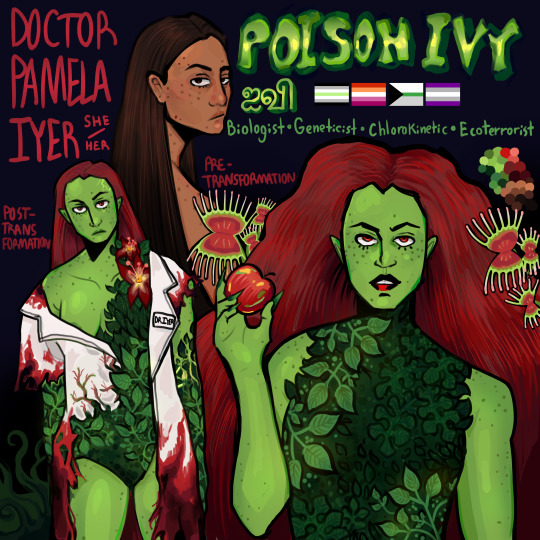
My poison ivy! I'm extremely proud of this. backstory under the cut :)
its been in the back of my head that ivy is indian since forever. i literally have no clue why its just There. she's tamil specifically, because i have favoritism regarding the script its written with.. it tickles my brain...
anyways heres my Poison Ivy: Origins comic i made last night in like 3 hours.
(theres a section here on her early life and the backstory of her parents that im still workshopping. basically she was a bastard child that only her mom supported and they left for gotham)
Bhavani got a job as an accountant for a law firm on recommendation from an uncle who had a company that worked in Gotham (he was kinder to the pair). She was always gifted in math. Bhavani raised her daughter the best way she knew how, even without the support of her family.
Pamela (now nicknamed Ivy due to multiple kids misreading her last name as Ivy. And she was very nature-focused even as a kid, digging in the dirt and identifying different kinds of trees using books she got at the Gotham Library with her mother) excelled in school, surpassing most of her peers. The pursuit of knowledge was the one thing she enjoyed. Her classmates were sticky and loud and irritating, and when she wasn’t ignoring them she was tying their shoelaces together as revenge for talking too loud during quiet time. She managed to make just enough casual friends to not worry her mother too deeply, but this was the start of a downward spiral.
She lost friends, and not many could take on the effort of befriending her. She lost herself in biology, the study of life. Especially plants and conservation. Plants were just so… simple, compared to human society. But their structures and functions and genetics were fascinating. She skipped grades to take higher-level classes on genetics. Her grades were phenomenal but her social skills were extremely underdeveloped. Not like Ivy cared. Humans were a plague on this earth, pumping the atmosphere with CO2 and poisoning rivers and cutting down forests. In her mind, they did nothing but harm the serenity of nature she so cherished.
After graduating with a PHD and doctorate, she got a job as a genetic engineer. She studied alternative ways to help regrow ecosystems after deforestation. Her Gotham University coworkers were wary around Ivy. She was a woman none of them knew anything about, who would say ecoterrorist-aligned comments offhandedly the few times she ever spoke.
Ivy was working on a genetically engineered plant on the day of the accident. It was designed to nurture plant species by sending chemical signals, and it took in energy through waste products left by deforestation and manufacturing. At least, in theory.
Ivy was working all alone in the lab at 2am. She hadn’t slept for hours, she was so close to her breakthrough. She was so close to making those billionaire bastards pay for what they did to the earth. She wasn’t wearing proper safety equipment nor using proper containment procedures during the incident. And as such, she was infected. The plant didn’t just take in waste material, it took in living flesh. Ivy’s cells were transformed in a gruesome fashion, her entire genetic code was re-written as it spread through her body. Her skin was green and her lab coat was bloody. Her newly-red hair flowed behind her as she escaped the lab, running through university grounds. Each footstep brought grass and dandelions cracking through the concrete in full bloom. Trees and grass grew to get closer to her, reaching for her.
Ivys powers were completely out of control. She was crying and hyperventilating as her mind was warped. It had given her a need for flesh. When she made it to Robinson park, she couldn’t overcome the primal instinct. Plants still crawling at her ankles, and she killed a squirrel with her bare hands and ate it raw. This only fueled her fractured mind to want more. Ivy's first ever murder was a pedestrian, who just happened to be in the wrong place at the wrong time. He tried to flee when he saw a bloody green woman with a squirrel carcass in her mouth, but it was to no avail. He was strangled to death with poison ivy vines, and eaten.
Finally, the primal instinct was satiated. Ivy escaped to a warehouse in the industrial district of Old Gotham. She tended to her injuries as best she could, soon discovering she had healing abilities. The injuries from her being torn apart had already mostly healed. She slept on an old couch, dreaming about what she could use these powers for.
When the news broke on the mysterious and grisly death of a random pedestrian, the media was all over it. Since he was killed by poison ivy, and from security footage the culprit was seemingly a woman, the media dubbed her Poison Ivy. Many believed it wasn’t possible, and that the footage was faked, but the GCPD was stumped.
Batman looked through the footage and, by process of elimination (matching the appearances of the scientists who had access to the laboratory, keycard scanners throughout that day and evening, as well as their known affiliations and potential criminal history. Two of them did deal weed but it was nonviolent and they didn’t match the woman in the tapes.)
Dr. Pamela Iyer was the clear suspect. She matched the woman's appearance (besides the green skin and hair, she was a tall woman with long straight hair and a flat nose.) Batman interviewed her coworkers and found she had a history of being antisocial with eco terrorist beliefs. None of them knew where she lived, however. And when the bat interviewed her mother (the only person her coworkers had ever heard her speak to in a positive light) she was very concerned. Suspicious of Batman, clearly, but worried for her precious daughter's well being. She said that Pamela had always loved being near nature, and that she didn’t care for the quality of structure she had to stay in. But other than that, her mother couldn't help. She does bring out the intimidating motherly stare at Batman, making him promise to bring her daughter home safely.
From here, Batman goes on a search. He prowls rooftops and streets and uses the grappling hook for fast travel. All while monitoring city-wide security cameras (thanks Alfred!) and paying attention to police radio. He stops muggings and thefts and helps get a cat out of a tree as he scans Old Gotham.
He came to the conclusion Poison Ivy must be in Old Gotham due to damage on the Robinson Park Bridge, connecting Somerset with the southern island. The damage matched with what had been seen on the sidewalks and streets near the University and the scene of the crime. Dandelions and crabgrass taking the shape of human footprints, cracking through concrete. Batman notices some trees down a certain alleyway in the east streets are warped inwards. Very similar to the trees in the park and university. He follows the unusual growth pattern of the trees, like they were hands outstretching to reach a light source.
There, he finds an old warehouse. He scales the building with a grappling hook, not wanting to be ambushed on the lower levels if he enters on the boarded up front door. Entering through an old broken skylight, he finds what must've been a long abandoned drug dealer hideout covered in fresh blood. Very, very carefully, he examines the scene. But there's nobody there. She just got away, her blood on the rotting old sofa is still warm. He also notes three strands of long red hair, which he places in crime scene baggies for DNA analysis.
His current theory is that the doctor was mutated by her own research. He read her notes and the plant she was experimenting with was extremely dangerous. And the security footage (before it cut out during what he believes was the time of the accident) showed her using improper safety equipment.
He’s on patrol for hours, but can’t find any sign of her.
That night, Bruce synthesizes a pesticide-like chemical that could prevent Ivy's powers. However, he talks to Alfred about how the plant would adapt to it almost like a bacteria, and that it might not be effective more than once.
The next morning Bruce Wayne is scheduled for a charity event. Many rich people are there tied to a business venture Wayne was not aware of. The event was for funding for healthcare systems in Gotham. Little does he know, this is the exact place Ivy plans to attack. She’s hated the rich for years and many politicians and businessmen that support an amazon rainforest deforestation project are there.
She interrupts their little charity event at a historical building in the financial district of old gotham with a surprise. Ivy broke into one of her old greenhouses at the university, taking small samples of extremely poisonous amazon rainforest plants with her. This happened quickly and silently while Bruce was still at the function.
Ivy crashed through the large art-nouveau stained glass windows, supported by giant vines. She is lifted down the staircase like she was floating, more vines and deadly plants crawling in from the giant hole in the glass, moonlight from the full moon peeking through the clouds and illuminating her entrance. London Planetrees from around the building grow in front of doors, sealing all the possible exits.
All of the rich and fancy people in dresses and suits meandering around the building are screaming and trying to run, which is when a mad-with-power Ivy releases her plants.
They grow to gargantuan sizes in moments, releasing toxic spores and fumes and burning people's skin. Ivy finds the most heinous offenders of the rainforest bill and feeds them deadly plants by hand, graphic symptoms ensue.
In the pandemonium, Bruce pulls out some tree facts about the flammability of a certain species, managing to throw a fire source directly at it as a diversion before escaping through a vent in the opposite wing of the hall. Alfred is already outside with the Batsuit, he brought it as soon as he learned of the attack.
Bruce suits up and re-enters. It's a grueling and difficult battle, the most difficult he has fought so far. He manages to spray Ivy with the chemical, and she goes down, all the plants in the hall going still. The excessive toxic fumes suddenly go back to normal levels. Bruce uses an extremely strong tranquilizer on her, she’s still fighting to get up. Finally, Ivy is defeated.
Almost the whole charity gathering was injured in the attack with seven people dead and immense damage done to the structure of the historical hall.
Ivy’s powers are sedated and she’s taken into police custody, where she is deemed insane. Half of the insanity conviction was her actual insanity and the other half was that Arkham is the only facility capable of holding her, especially since it’s located on an island. Batman agrees with Jim Gordon on this comment.
Ivy didn’t say anything during her trial, silently glaring with little remorse. The physician diagnosed her with ASPD (which wasn’t right but it's on her legal documents.)
The comic ends with Ivy in Arkham, talking about the rich swine tearing apart the world, and how she finally has the power to stop them. How she can feel the mutation inside of her slowly winning against the sedative drugs, adapting and consuming the chemical to turn it into energy as it was designed to do. How she will return the world to ecologic harmony, with her own hands. It ends with her in the Arkham cafeteria, staring at a mysterious blonde prisoner a few tables across…
the writing isn't like, a fanfiction. its a guideline for a comic in a series of origins comics im planning. do not get your hopes up these'll be done in like, 10-20 years at my current speed. i have a scarecrow and riddler outline in the works, and plans for a batman, joker, harley quinn and probably a penguin comic eventually. and more villians. once i'm done with all the origins comics i'll be doing like, a regular batman series. just for fun yknow.
#poison ivy#pamela isley#the blonde woman was harley this is 100% a harlivy endgame universe#dc fanart#gotham rouges#harlivy#dc#poison ivy fanart#this plant creature and this gay girl wanna FUCK#ivys the type of fucked up fool to get gender euphoria from being called a critter. an organism even#just like me fr....#harley steals blood donor bags from local hospitals on ivys birthday its like cannibal wine tasting#ivys a cannibal she has to eat raw meat but she doesnt have to eat human meat#its like 2 birds with one stone to her yknow#outletverse
60 notes
·
View notes
Text





NEW TO NOT S&P APPROVED!
The ultimate Mystery Shack button-down shirt!
A super-soft 65% recycled polyester button-up shirt, with an exclusive Mystery Shack pattern by Not S&P Approved - inspired by Grunkle Stan's own wardrobe. Available exclusively in a boxy, gender-neutral, super-relaxed fit. Made to order by our trusted partners.
Please be aware that these shirts are cut and sewn to order - this is more eco-friendly, reduces waste and keeps our quality high, but does take a while. Make sure you keep an eye on our processing time!
Don't like your shirts super baggy? Size down when ordering!
"Hey! Ya ever think, 'Man, all of these t-shirts are fine, but where's somethin' classy to dress in?' - I know I do whenever I'm out on the town (to pick up my prescription) - and I decided to answer your prayers. This is the work of at least eight hours Mabel-labour (paid in gummy worms) and sixteen hours Soos-labour (unpaid)… The Shack Special!
Covered in a custom woodsman check, this super-lightweight shirt features a design featuring some of the signs and sights of the Mystery Shack, and even features a 'forest view' inner yoke. Other folks might not be able to see it, but you'll know that, in your mind, you're in the rich-smelling Pines of Oregon. Probably eating a Mystery Dog and spending your hard-earned cash with me, your favourite Grunkle.
To make things that little bit sweeter, I've done my best to get this shirt some credentials. It's OEKO-TEX 100 Standard and Global Recycled Standard (GRS) certified, and is manufactured according to United Nations Global Compact Principles.
Now ya can't say fairer than that. Right? Right. Whadya waitin' for?!"
65% Recycled Polyester / Polyester blend
Cut & sew with allover sublimation print
Super-relaxed overshirt fit (please size down for a 'true fit')
Lightweight moisture-wicking fabric made by United Nations Global Compact companies
OEKO-Tex 100 Standard
GRS Certified
Please note that we can't accept returns on shirts that have been worn, in the interests of hygiene. We will be able to tell. We've got a literal pig on our product team.
OUT NOW!



#gravity falls#gravity falls fandom#not s&p approved#stan pines#grunkle stan#mystery shack#gravity falls merch#etsy
48 notes
·
View notes
Text

Tumblr won't turn the URL into a link card for whatever reason, so, here's a Washington Post article about Israel using white phosphorus in Lebanon. Some key points here, full text under the cut:
White phosphorus is technically legal when used to obscure military activities and at a distance from civilians. In this case it was directly targeted at homes in Dheira, a village near the Lebanese border with Israel. 4 homes were incinerated and 9 people injured in this particular attack on 10/16. Residents have been displaced.
Amnesty International has called for this to be treated as a war crime.
The white phosphorus munitions are US-made according to unnamed weapons experts, Amnesty International, and the Post itself. They appear to have been manufactured in 1989 and 1992. The Biden administration claims not to have included white phosphorus in arms transfers to Israel since 10/7.
The IDF claims these were used to create obscuring smoke and not to target civilians; they possess safer munitions that would do the same thing without contaminating bodies, soil, and buildings, but did not use those.
A part that deserves highlighting in full: "Israeli forces continued to shell the town with white phosphorus munitions for hours, residents said, trapping them in their homes until they could escape around 7 a.m. the next morning. Residents now refer to the attack as the 'black night.' Most fled the town when the shelling stopped, returning during a week-long pause in fighting and leaving again when it resumed. Uday Abu Sari, a 29-year-old farmer, said in an interview that he was trapped in his home for five hours during the shelling and was unable to breathe because of the smoke. He suffered respiratory problems for days after the attack. 'Emergency services told us to put something that was soaked in water on our faces, which helped a bit. I couldn’t see my finger in front of my face,' he said. 'The whole village became white.'"
"White phosphorus fell onto several homes and ignited fires, incinerating furniture and stripping appliances to scorched metal. Remnants of the sticky, black chemical littered the ground 40 days after the attack and combusted when residents kicked at it."
US officials, as usual, expressed "concern" and an intention to "learn more," which of course means nothing.
As a reminder, this is not a unique attack on Lebanese soil since the slaughter started. "Israel has used the munition more than 60 times in Lebanon’s border areas in the past two months, according to data collected by ACLED, a group that monitors war zones. Lebanese Prime Minister Najib Mikati said on Dec. 2 that Israel’s use of the munition has 'killed civilians and produced irreversible damage to more than 5 million square meters of forests and farmland, in addition to damaging thousands of olive trees.'"
By William Christou, Alex Horton and Meg Kelly
Updated December 11, 2023 at 3:48 p.m. EST | Published December 11, 2023 at 6:00 a.m. EST
DHEIRA, Lebanon — Israel used U.S.-supplied white phosphorus munitions in an October attack in southern Lebanon that injured at least nine civilians in what a rights group says should be investigated as a war crime, according to a Washington Post analysis of shell fragments found in a small village.
A journalist working for The Post found remnants of three 155-millimeter artillery rounds fired into Dheira, near the border of Israel, which incinerated at least four homes, residents said. The rounds, which eject felt wedges saturated with white phosphorous that burns at high temperatures, produce billowing smoke to obscure troop movements as it falls haphazardly over a wide area. Its contents can stick to skin, causing potentially fatal burns and respiratory damage, and its use near civilian areas could be prohibited under international humanitarian law.
Of the nine injured in Israel’s attack on Dheira, at least three were hospitalized, one for days.
Lot production codes found on the shells match the nomenclature used by the U.S. military to categorize domestically produced munitions, which show they were made by ammunition depots in Louisiana and Arkansas in 1989 and 1992. The light green color and other markings — like “WP” printed on one of the remnants — are consistent with white phosphorous rounds, according to arms experts.
The M825 smoke rounds, fired from 155mm howitzers, have legitimate use on the battlefield, including signaling friendly troops, marking targets and producing white smoke that conceals soldiers from the eyes of enemy forces. The rounds are not intended for use as incendiary weapons.
The weapons are part of billions of dollars in U.S. military arms that flow to Israel every year, which has fueled Israel’s war on Hamas in the Gaza Strip, launched after the militants attacked on Oct. 7. At least 17,700 people, many of them civilians, have been killed since the Israeli operation began, according to the Gaza Health Ministry.
Following publication of this story, National Security Council spokesman John Kirby said Monday the administration is “concerned” about the use of white phosphorous munitions and that they would be “asking questions to try to learn a bit more.”
Tensions along Lebanon’s southern border between Israeli forces and Hezbollah, the Iranian-backed militia, have boiled over from a simmer to near-daily exchanges of fire in the weeks since Oct. 7.
Dheira, a town of 2,000, has become a focal point for fighting. Just across the border from an Israeli radar tower, it has been used as a staging ground for Hezbollah’s attacks against Israel. At least 94 people have been killed on the Lebanese side of the border since tensions escalated, according to data released on Dec. 5 by the Health Ministry — 82 have been militants, according to Hezbollah. In addition, at least 11 Israelis have been killed, most of them soldiers.
Photos and videos verified by Amnesty International and reviewed by The Post show the characteristic ribbons of white phosphorus smoke falling over Dheira on Oct. 16.
Israeli forces continued to shell the town with white phosphorus munitions for hours, residents said, trapping them in their homes until they could escape around 7 a.m. the next morning. Residents now refer to the attack as the “black night.”
Most fled the town when the shelling stopped, returning during a week-long pause in fighting and leaving again when it resumed.
Uday Abu Sari, a 29-year-old farmer, said in an interview that he was trapped in his home for five hours during the shelling and was unable to breathe because of the smoke. He suffered respiratory problems for days after the attack.
“Emergency services told us to put something that was soaked in water on our faces, which helped a bit. I couldn’t see my finger in front of my face,” he said. “The whole village became white.”
White phosphorus ignites when in contact with oxygen and burns at temperatures up to 1,500 degrees, which can cause severe injuries. The chemicals left in the body can damage to internal organs, sometimes fatally, according to a Human Rights Watch report.
It is unclear why the Israeli military fired the rounds into the evening, as smoke would have little practical use at night and there were no Israeli troops on the Lebanese side of the border to mask with smokescreens. Residents speculated that the phosphorus was meant to displace them from the village and to clear the way for future Israeli military activity in the area.
In a statement, the Israel Defense Forces wrote that white phosphorous shells launched by Israel are used to create smokescreens, not for targeting or causing fires. It said its use of the weapon “complies and goes beyond the requirements of international law.”
Israeli forces possess safer alternatives, such as M150 artillery rounds, which produce screening smoke without the use of white phosphorous.
The U.S. origin of the shells was verified by Human Rights Watch and Amnesty International. The same manufacturing codes also appear on white phosphorus shells lined up next to Israeli artillery by the city of Sderot, near the Gaza Strip, in an Oct. 9 photo.
The United States is under an obligation to track the behavior of its partners and allies who receive its assistance in order to comply with U.S. law, humanitarian law experts said. The use of white phosphorus smoke is permitted if used for legitimate military operations, but like other weapons, its misuse can violate laws of armed conflict. Rights groups have warned its use should be restricted around civilians because fire and smoke can be spread to populated areas.
“The fact that U.S.-produced white phosphorus is being used by Israel in south Lebanon should be of great concern to U.S. officials,” Tirana Hassan, the executive director of Human Rights Watch, wrote in an email. “[Congress] should take reports of Israel’s use of white phosphorus seriously enough to reassess U.S. military aid to Israel.”
The United States is not conducting real-time assessments of Israel’s adherence to the laws of war, Biden administration officials said.
“Anytime that we provide items like white phosphorous to another military, it is with a full expectation that it’ll be used in keeping with...legitimate purposes and in keeping with the law of armed conflict,” Kirby said.
It is unclear when the United States delivered the munitions to Israel. The U.S. has not provided white phosphorous munitions to Israel since the Oct. 7 Hamas attack, Pentagon spokesman Maj. Gen. Pat Ryder told reporters Monday.
“When it comes to our relationship with Israel, we’ll continue to communicate to them the importance of mitigating civilian harm,” Ryder said, adding that the department could not yet verify the weapons were from U.S. stocks.
White phosphorus fell onto several homes and ignited fires, incinerating furniture and stripping appliances to scorched metal. Remnants of the sticky, black chemical littered the ground 40 days after the attack and combusted when residents kicked at it.
In 2009, Human Rights Watch documented Israel’s use of U.S.-made white phosphorus munitions in violation of international law in its 22-day offensive in Gaza. At least one of the shells found by The Post in Dheira was from the same batch of white phosphorus used by Israel in 2009, according to lot production codes.
In 2013, the Israeli military pledged to stop using white phosphorus on the battlefield, saying it would transition to gas-based smoke shells.
Israel has used the munition more than 60 times in Lebanon’s border areas in the past two months, according to data collected by ACLED, a group that monitors war zones. Lebanese Prime Minister Najib Mikati said on Dec. 2 that Israel’s use of the munition has “killed civilians and produced irreversible damage to more than 5 million square meters of forests and farmland, in addition to damaging thousands of olive trees.”
Tyler Pager aboard Air Force One, Missy Ryan in Washington and Mohamad El Chamaa in Beirut contributed to this report.
71 notes
·
View notes
Text
I think the other thing that bothers me with the flood of AI into everything is how grandiose the companies marketing it make it seem. A Meta AI ad (when every Meta commercial is equally pretentious, ngl) treats it as the next great thing to bring the world together, an inspiration to us all, making our lives easier, yada yada.
The part of that commercial that stuck with me was this lady on a train, looked like a student, asking the Robot to summarize something for her. Looked like a page of notes. And like… lady you aren’t learning a damn thing if the Robot takes your notes and then summarizes them. Yes we’ve always had the means to cheat and no attempts to defend against it will ever work so long as cheaters lack the desire to learn, or suffer under too much pressure to get a good grade over an actual education.
Pretending you didn’t manufacture the problem your new product exists to create is nothing new. Tech is just like that. Capitalism is just like that. But I see people, smart people, buying into this bullshit and not seeing the forest for the trees. AI as a concept isn’t the problem, I know this. “AI” is such a broad term that lumping extremely useful tools in with art theft doesn’t help either side of the argument.
I don’t think for a second that any of the companies pushing it feel an ounce of guilt or had a shred of forethought before unleashing their utopian tools onto the market beyond the profits they could make. I don’t think the people who first made it did so maliciously. I’m just sick of the argument that “it’ll make lives easier and that’s worth the side effects”.
I was a student who rarely had to study for things—if I didn’t learn it in class during lecture, staring at my notes and cramming the night before the test wouldn’t fix anything. I had a very good retention of knowledge and a mental block to the concept of studying.
But when I really needed to make sure I didn’t wing it on a test, shocker, studying actually helped. I’d completely skipped over a concept on the study guide when reviewing, and that was the only question I got wrong on that test.
So seeing that actress on the train, pretending like the Robot summarizing her notes, while she’s on a train and has nothing better to do with her time anyway, as if it will in any way help her in the long run, is bullshit.
Nobody’s saying that artificial intelligence in medicine or forensics or computer science is a bad thing. It’s supposed to make the hard jobs, the menial jobs, the jobs that human error cannot compete with, easier. It’s not supposed to remove any sense of ambition, of trial and error, of failure and learning from it.
I can’t say these people had no idea what the world would do with these tools. Did you not think someone would use ChatGPT to cheat and do their homework and write their essays for them? Did you not think freelance writers and graphic designers would get fired en masse by cheap companies who can consult a computer for free? Did you not think copyrighted art, made by artists who are already struggling, would be stolen, and that they’d be mad about it? Did you not think singers and musicians might have something to say about their voices, wholly unique to them, and their lyrical and songwriting ability, being generated by a machine for free? Did you not think about the rampant misinformation that would abound by a robot that cannot have integrity, common sense, or think critically? Did you not think about how easy it is now to forge political images and speeches, to incite violence in gullible people who can’t spot a fake? Did you not think about how those images can start wars and cause catastrophe?
If you thought people would only use it for Instagram filters and generating surrealist nonsense at parties, you're criminally naive.
Piracy has always existed. Cheating has always existed. Ripping off someone else's book or script or speech or art style has always existed. The thing is though, that piracy comes with a risk of viruses and malware if you don't know what you're doing. Cheating takes finesse and risk if you get caught, especially now. Ripping off another's work still takes the time and effort to replicate it by hand. AI didn't invent any of this, AI just removed the barrier of entry and asked, why not?
I’ve quoted this movie before in my argument but goddamn, nothing fits better:
"Don't you see the danger, John, inherent in what you're trying to do here? Genetic power is the most awesome force the planet has ever seen but you wield it like a kid who's found his dad's gun.... I'll tell you the problem with your scientific power that you're using. It didn't require any discipline to attain it. You know, you read what others had done and you took the next step. You didn't earn the knowledge for yourself, so you don't take any responsibility for it.
"You stood on the shoulders of geniuses to accomplish something as fast as you could and before you even knew what you had, you patented it, and you packaged it, and you slapped it on a plastic lunch box and now you're selling it. You're selling it.
"Your scientists were so preoccupied with whether or not they could, they didn't stop to think if they should."
--Ian Malcom, Jurassic Park
17 notes
·
View notes
Text

Should post this even if there's more to do here, tbh I want to make a vector version, It'd probably be easier to edit. Wanted to try and figure out the various provinces of Jacanti. The shapes of these are subject to change, which is part of why I considered not posting this. But I should actually share my stuff here, even if it isn't finished. I have some fairly tangible projects in mind and might start thinking of this blog as a place to post development work, maybe it'll make me feel less paralyzed and more productive? Anyways, Jacanti.
The southern tip of one yet unnamed continent is controlled by the Jacantese Empire. Colored areas are just regions and not official administrative divisions. Rundown under the cut.
The Bitano (in gold, the Gut): savanna in the west and desert and mountains in the east, the cultural epicenter of the empire. The capital of Godtomb, located on the western shore, is the central holy site of the Hegemonic culture's religion (many things need named lmao). Has the emperor, has the government, has the actual bones of the slain God (the name is literal). Cereal crops and cattle. The provinces of the Bitano tend to receive preferential positions in the governmental Orbits, although there's nothing in writing to indicate them as more privelaged. It's a matter of cultural and ethnic chauvinism, a bit of nepotism, etc.
Zutnonva (in serpentine, the Lungs): mountain and rainforest. Its difficult terrain has led many populations to become quite isolated and is surprisingly culturally and linguistically diverse, despite the efforts of Jacanti itself. Actively being settled. Has a few "uncontacted" hostile populations that are nevertheless surrounded and extremely outclassed, but also ignored where they exist on land not seen in any way as valuable by the Hegemonic culture, at least for the moment.
Micad (in azure, the Heart): plains and monsoon forest. Increasingly industrialized and still feeling the fallout of a failed rebellion several decades ago. Differing interpretations of religious law and building frustrations with conservative mandates on the proper standards for dagnyd manufacture lead to a violent, 8 year conflict which was eventually quashed. The war might have been lost, but the sentiments which lead to its ignition have remained smoldering.
#jar of mice#trying to kick myself into posting even if what im posting is unpolished rough ideas#jacanti
45 notes
·
View notes
Text

[WESKER'S REPORT / EXTRA]
A very intriguing incident . . .
A series of bizarre murder cases have been occurring at a wintry village in the rural Caucasus region of Russia. The villagers there are clamoring about a legendary monster, "Almas", having risen from the dead . . .
This wretched state of affairs effortlessly reminds me of those initial bizarre cases in Raccoon Forest. Three kilometers away from that village there stands an antiquated chemical plant built during the Soviet era, ownership of which, according to our investigation, currently lies with a prestigious European aristocrat.
Foreign capital appears to have been invested five years ago for undertaking major underground development. Geological surveys reveal the presence of solid bedrock, perfect for constructing a certain kind of facility.
It would seem as though we've solved the puzzle. Umbrella has shamelessly clung to life in the five years since Raccoon's annihilation. Despite facing accusations of leaking the virus along with their stock prices crashing, they unfurled the trial with a campaign claiming it all to be a U.S. Government conspiracy, which has been successful in stalling for time until their eventual death sentence.
Fortunate for Umbrella, then, that they had been colluding with the government from the beginning. A state naturally has secrets of its own that can be dusted off, and their survival tactic was to sell those off piece by piece to the court and mass media in order to foment public skepticism. Something akin to madness lurks more or less within every person and organization, even among nations.
The most deranged in that incident, however, was none other than Umbrella. A simple-minded Umbrella is exhibiting signs of a revival. B.O.W.s are starting to overrun war zones. They are supplying those B.O.W.s as weapons. We've also received reports that, beneath the surface, Umbrella have arranged a framework for manufacturing bioweapons while operating ships to transport them.
The time has come. They tinker with the t-Virus, cultivate mutant organisms, then sell them. Moreover, even if they were to yield certain results, with their capacity for imagination incapable of treating the virus as anything more than a vector for bioweapon production, they will only end up exposing their defects at some other point in time.
The "Philosopher's Stone" is destined for the hands of a truly worthy alchemist. The unworthy must be taken off the stage.
This place is sure to be the site of Umbrella's end.

14 notes
·
View notes
Text
Which Are The Best Forest Products In India?
India is making the best use of its forests. The country has the largest forest based industries in the world, and most of its forest products are exported to foreign markets. India produces approximately 2 million tons of dyes every year from red sander (bright red), Khair (chocolate), flowers of Palas, fruits of Mallotus phillipensis, the bark of wattle, and roots of Morinda tinctoria. This production makes dyes one of the leading forest products industry in the country.
#forest based industries#forest products industry#forest products in India#shellac export promotion council#forest products manufacturers in India
0 notes
Text
In Liu Cixin’s science fiction novel The Dark Forest—part of the popular Three-Body Problem series recently serialized by Netflix—humanity is faced with the prospect of an alien invasion. The extraterrestrials are on their way to conquer Earth but are still light years away; humanity has hundreds of years to prepare for their hostile arrival.
Amid a need to bolster defense spending globally and, crucially, to foster innovation across the entire world, representatives of the global south make a proposal at the United Nations. Developing countries demand a universal waiver of intellectual property protections on inventions relevant to defense to enable them to develop their own technologies and contribute to planetary fortification. In Liu’s story, the global south’s call meets staunch opposition from wealthier states, which veto the proposal. Although set in an imagined future, Liu’s point resonates clearly in our own time.
The most recent parallel is the global vaccine hoarding that occurred during the COVID-19 pandemic.
At the height of the emergency, rich countries bought up and hoarded COVID-19 vaccine supplies, which left many developing countries unable to obtain sufficient vaccines during 2021-22. Even when they arrived, donations of leftover doses from high-income countries were often too close to their expiration dates for developing countries to actually use them.
Global south states sought to build up their own secure vaccine production capacity but were stymied. Critically, vaccine manufacturers, such as Moderna and Pfizer-BioNTech, refused to share IP-protected technology with World Health Organization (WHO) initiatives, such as C-TAP and the mRNA vaccine technology transfer hub, that were attempting to create a network of distributed vaccine production. It is estimated that such hoarding cost more than 1 million lives in developing states.
Remarkably, the global south saw this coming. Even before a single COVID-19 vaccine had been administered, developing countries accurately anticipated that they would be left at the back of the line for supplies. Burned by the experience of HIV/AIDS medicine shortages in the late 1990s and early 2000s, the global south predicted similar inequities occurring during the COVID-19 crisis—and they tried to act to prevent this.
In October 2020, this foresight motivated developing countries, led by South Africa and India at the World Trade Organization (WTO), to propose an international waiver of IP protections—known as a TRIPS waiver—on COVID-19 vaccines, treatments, and other health technologies. Much as in Liu’s story, the global north firmly rejected the proposal, leading to a delayed and watered-down WTO decision in June 2022 that I, and other academic experts, argued was too little, too late.
Crucially, we can observe the same pattern emerging yet again in the current negotiations over the WHO Pandemic Accord. Just like Liu’s vision of humanity preparing for an inevitable alien invasion but unwilling to share technologies globally, the world remains stuck in a doom loop. Another pandemic is foreseeable. A new treaty could provide a way for the international community to learn the lessons of COVID-19 and boost pandemic preparedness. Yet the world is making the same mistakes all over again.
Given the failures of the WTO process, experienced commentators such as Ellen ‘t Hoen anticipated that shifting the debate to WHO could help ensure that similar inequalities do not arise during the next pandemic. Many hoped that WHO, with its overriding focus on global health, would be a more receptive forum to the global south’s equity concerns than the WTO, which prioritizes IP via TRIPS, one of its foundational 1995 agreements.
However, thus far, the negotiations have been hampered by the same issue that blighted the WTO TRIPS waiver process: Rich states are unwilling to agree to any potential pandemic-related limitation of international IP rights or to expand IP flexibilities to include nonvoluntary options such as a mechanism for the compulsory licensing of trade secrets on pharmaceutical manufacturing processes needed for scaling up production of pandemic products.
Broadly speaking, developing countries want terms that would mandate technology transfer of key health technologies, such as vaccines, to the global south. Rich countries decry this suggestion, claiming it could undermine IP rights.
Hence, wealthy nations are balking at the use of progressive language on the compulsory use of IP in Article 11 of the draft accord. Instead, the U.S. government emphasizes supporting voluntary agreements—without acknowledging that the voluntary systems, including COVAX, failed to provide for the needs of citizens in many global south countries during the COVID-19 era.
In these negotiations, several key parties, such as the European Union and the United Kingdom, argue that a WHO treaty cannot deal with IP issues because that would equate to trespassing on rules that the WTO created. This back-and-forth between the WTO and WHO reflects an asymmetric power game that the global south is not well placed to win.
With no movement on IP, developing countries seem less willing to agree on a rare point of leverage, namely, the terms of Article 12, which addresses pathogen access and benefit-sharing. Put simply, developing countries are concerned that if they agree to terms on restriction-free sharing of pathogens with pandemic potential, without reciprocal guarantees of technology-sharing and health product distribution, they will be left at the back of the line again in the next pandemic.
Wealthy countries may be succeeding at reducing this leverage; recent news reports suggest that detailed provisions on pathogen-sharing may be shifted to a separate instrument.
It seems that for rich states, property is sacrosanct; global health is not. Yet, rather than property, it is worth recalling that patents were originally considered to be a form of state-granted privilege. In the 19th century, industrial states viewed IP not as an instrument of free trade but rather as a form of trade protectionism.
This idea of IP as protectionist privilege remains a more accurate description of what global IP law is intended to achieve. Much as in Liu’s novel, the stark reality is that there is no circumstance—not a new pandemic, not even an alien invasion—in which the global north would be willing to give up its protectionist privileges by sharing its technology with the global south.
With the WTO in decline and the WHO multilateral process in trouble, the global south may have to examine alternative options for building up pandemic preparedness. Intriguingly, Netflix’s 3 Body Problem envisages this. Unlike in the book, on TV the U.N. resolution for open technology-sharing is never even proposed.
Instead, a Mexican national who happens to be the chief scientific officer of a cutting-edge nanotech company becomes frustrated by Western corporate-military obstructionism and decides to upload all her London-based employer’s source code and trade secrets to open-source platforms with the aim of assisting developing countries to produce the technology. She even includes a downloadable guide on how to copy the functionality of the technology while avoiding IP infringement.
This fictional feint away from the multilateral forum and toward individual decision-making parallels real-world moves toward open-source biotech. This approach has been pioneered by Peter Hotez and Maria Elena Bottazzi of Baylor University, who created the patent-free COVID-19 vaccine Corbevax. They successfully transferred the vaccine technology openly to producers in Botswana and India. Meanwhile, the WHO mRNA hub at Afrigen in South Africa led by Petro Terblanche is encouraging open south-south collaboration on new vaccine technologies.
If the Pandemic Accord negotiations falter before the World Health Assembly begins on May 27 or they fail to produce a just treaty, efforts such as these will take on even greater importance. An inequitable Pandemic Accord will signal that Liu was right: The global north will continue to hoard technologies even in the face of looming Armageddon, and south-south collaboration on producing health technologies may be the only way forward for enhancing global pandemic preparedness.
20 notes
·
View notes
Text

Another year, another birthday! Normally I don’t draw much attention to it, but it’s been a rough year, and I want to celebrate my surviving of it by recommending 10 works from mutuals that live in my head RENT FREE forever! Please enjoy them with me, and feel free to shout at me about them in the DM’s, it will make my day!
1. Devil’s Snare All The Way Down by @malpal132
Pairing: Pansy Parkinson/Neville Longbottom
Rating: E
This is a gorgeous Pansy Parkinson character study, spanning her younger years to post-hogwarts. She becomes reacquainted with Neville Longbottom and discovers who she’s meant to be in this slow-burn ETL.
2. Down a Hill at High Speed by @tepre
Pairing: Harry Potter/Draco Malfoy
Rating: E
This 8th year fic is the BEST sex-pollen trope story I’ve ever read. Period. Tepre is a genius with sexual tension.
3. May Contain Nuts by scoradh
Pairing: Harry Potter/George Weasley
Rating: M
This is the fic that I REFUSE TO SHUT UP ABOUT (sorry if you’ve been caught in the crosshairs.) George is trying out a new line for XXX products at the joke shop. Harry is George’s go-to for product testing. Contains found family, dubious sweets, broken George, and NUTS of course! *Note the Archive warning for MCD is in reference to Fred, I think. No Harrys or Georges are harmed in the making of this fic.
4. Savour by @mignon-chignon
Pairing: Hermione Granger/Draco Malfoy
Rating: E
This is just pure PWP. And all my favorite kinks. Definitely not safe for ANYTHING but a quiet room, a glass of your favorite beverage, and a favorite toy. Mind the tags.
5. Like a Brother Would by @wolfpants
Pairing: Harry Potter/Ron Weasley
Rating: E
This Deathly Hallows AU explores the posibility of Ron returning back to the tent that night in the Forest of Dean. I can’t tell you how many times I’ve read and reread this. I’m obessed with this friends to lovers pairing, this vulnerable and delicious fic. One of the best Ronarry I’ve ever read.
6. The Luxury of a Regret by @swoontodeath
Pairing: Horace Slughorn/Regulus Black, Horace Slughorn/Sirius Black
Rating: E
IT’S A DEAD DOVE, FOLKS! But it is so creepy and beautiful. I CANNOT stop thinking about it. Imagine if this were canon, Slughorns obession with Harry would be THAT MUCH CREEPIER.
7. Hate, Lead the Way! by oh_black_sparrow
Pairing: Walburga Black/Orion Black
Rating: E
One of the Rare Pair fest 2022 stories I fell head-over-heels in love with. We know her as the shrewish shrieking portrait permanently stuck to the wall in 12 Grimmauld Place, but in this rage-filled story, she’s a force to be reckoned with.
8. Manufacturing Consent by onefiftyeight
Pairing: Lucius Malfoy/Hermione Granger
Rating: E
HEAR ME OUT. I don’t normally go for this pairing, but THIS FIC is deliciously sinister. A masterclass in gaslighting and manipulation. A breeding kink extravaganza. Crack at its finest. Give it a chance, I promise you won’t regret it. Mostly.
9. Hot and Bothered by @roseharpermaxwell
Pairing: Ron Weasley/Draco Malfoy, background Dramione
Rating: T
Who’s the better kisser? Only one way to find out… (Guys. This is reason #1 why Dron is amazing. Mic Drop.)
10. I Like Your Skirt by @the-francakes
Pairing: Ron Weasley/Harry Potter
Rating: E
Aside from the fact that Fran is lovely and wrote this gift for me, RON AND HARRY are SO YUMMY IN THIS!!! Dual POV, Friends to Lovers, flirting, pining and no small amount of filthy content. The epilogue chapter (bonus smut) is to die for. It will forever reside in my wank bank.
*****
Stay tuned for part 2... (self-recs!)
#Birthday#Harry Potter fics#Ronarry#Dron#Lucius x Hermione#Draco x Ron#Ron x Harry#Rarry#Walburga x Orion#Horace x Regulus#Horace x Sirius#Dramione#DHr#Draco x Hermione#Harry x George#Firebolt#Panville#Pansy x Neville#Paneville#Draco x Harry#Drarry#mutuals#fic recs
89 notes
·
View notes
Text
An emerging socio-bioeconomy
The concept of socio-bioeconomy acknowledges the intricate ties between biodiversity and socio-cultural systems. It advocates for sustainable production chains, protects genetic heritage, values traditional community knowledge, stimulates job creation and income generation and positions itself as a strategy for climate change adaptation.
Applied to the Amazon context, the socio-bioeconomy approach presents a vast spectrum of opportunities for generating innovative products, all the while promoting sustainable economic growth and preserving biological, cultural and social diversity. This bioeconomy already exists, but it´s far from reaching its full capacity.
Key opportunities include:
• The development of nutrient-rich superfoods production, such as the products produced by Awi Superfood. This company turns natural ingredients, such as açaí, cupuaçu, camu-camu and nuts, into sorbets and ice creams.
• The manufacturing of natural rubber used in tyres, shoes and fashion, such as produced by VEJA shoes.
• Advanced scientific research on plant species for developing new health products. Ecoflora, for example, has developed a stable, natural blue colourant for the food, beverage and cosmetic industries.
• Sustainable tourism that showcases the region's rich biodiversity and cultural heritage could also thrive. Sumisawa is showing what can be done here.
• Beyond direct biodiversity use, technology-driven businesses have vast potential to enhance forest and bioeconomy competitiveness, with startups addressing the region's unique energy, water, logistics and fire management challenges. For example, Umgrauemeio, with its Pantera platform, provides integrated solutions for fire risk prevention, instant and early detection, fast response and impact analysis, helping to mitigate the devastating effects of mega-fires in various ecosystems.
source
#socio-bioeconomy#amazon#solarpunk#solarpunk business#solarpunk business models#solar punk#startup#indigenous knowledge
9 notes
·
View notes
Note
Hello! I'm not sure if my question will meet the criteria you posted regarding asks/headcannons/fanfics (itz my first time hehe), but I gotta ask 😅: If Thranduil, his wife, and the 5 brothers had lived in the modern times, what would their lives be like (ex. jobs, lifestyles, modern interests, etc.)? Basically a modern au of sorts...? I understand if you do not answer my question if it really didn't meet the criteria, but if you do answer, thanks in advance!
MODERN AU: THE ROYAL FAMILY OF MIRKWOOD
The House of Thranduil
Modern AU set in the United States (this writer is American and doesn't want to embarrass herself speaking of other countries, lol)
Fair Warning: This entire family is ridiculously accomplished in this AU, but this is clearly fictional so just ride along the fantasy with me!
Apologies for the length and infodump style--my mind really ran off with this concept!

Thranduil, The Patriarch

Businessman/CEO and 4th generation landowner.
Land ownership currently includes 1 million acres of timberland around the West Coast.
Business holdings include logging, saw mills, wineries, and forest-product manufacturing companies that employs thousands of employees.
Attended Wharton School to study business but dropped out in his third year when his father passed; (reluctantly) took over the company at 21 years old to prevent it from being seized by his father's scheming partners.
Met and fell in love with Maereth, a classmate at Wharton, but she was already in a relationship with someone else.
Continued to pursue her over the course of 10 years until they finally wed right before he turned 30.
His family home is a 2,000-acre ranch in Northwest Oregon, but he travels constantly all over the country.
During the economic downturn, saved the business and his people's livelihood by selling off a third of the family's acreage.
Refuses opportunities to expand in favor of maintaining fair wages for his employees and ethical and environmentally sound practices.
Personal hobbies include breeding and racing horses, outdoor activities, wine-collecting, and travel.
Despite rubbing elbows with powerful, rich businessmen like himself, he despises that crowd and spends only as much time with them as necessary for business.
His closest friends are the folks in his small hometown and the employees who work alongside him.

Maereth, The Matriarch

Born to a lower-middle class family from Scranton, Pennsylvania. Father was a construction laborer and mother was a part-time receptionist.
The middle child and only daughter; has 3 brothers.
Only one in her family to attend and finish college.
Practically engaged to her boyfriend at the time she met Thranduil.
Despite her rejecting Thranduil's advances and professions of love because of her existing relationship, she felt attracted to him and could not bring herself to forget him. They maintained a friendship after Thranduil dropped out of Wharton and moved back West.
Once her relationship with her boyfriend ended, Thranduil resumed courting her, but she rejected his marriage proposal out of a desire to pursue a career on her own.
Started her own company and ran it for several years before selling it at a large profit. Used the money to pay off her family's loans and help her parents retire.
Was finally won over by Thranduil's persistence and obvious devotion, and agreed to marry him.
Gave birth to their five sons over the course of a single decade.
Raised her children as a stay-at-home mom until they all reached their teens.
Currently sits on the board of the family's corporation and serves as the Chief HR Officer.
Chairs the family's private foundation that gives millions to charitable causes annually.
Is a talented crafter, craftsman, and builder, more so than her husband and most of her sons (except for Mirion), with enough skill to complete simple remodels on her own. She is the ultimate DIYer who dives eagerly into manual labor, which is one of the things Thranduil admires most in her.
Is also a successful gardener, able to keep flourishing backyard gardens that bear flowers, fruits, and vegetables of different kinds.
Spends most of her free time on endless home improvement projects or traveling as needed to visit her sons.

Mirion, eldest son - The Heir

The dutiful son who accepted his role as the eventual heir to the company. Started shadowing his father as a teen.
Married to his high school sweetheart, with whom he has two children (so far the only grandchildren of Thranduil and Maereth).
Lettered in 3 high school sports: baseball, football, and track, but discontinued sports in college to focus on academics.
Holds a degree in materials engineering from Carnegie Mellon University.
Upon marrying, settled his family at a ranch house in Oregon to stay close to his parents and majority of their holdings.
Started his own construction company that eventually became a part of the family conglomerate.
Was a stay-at-home dad for several years to allow his physician wife to return to her small town practice.
Attends many high-profile social engagements on behalf of his parents.
The ultimate dad: very involved in his kids' lives and is beloved by their friends; their home is a popular hangout for the neighborhood kids.
Constantly hit on by single moms and dads; unfortunately for them, he is singularly obsessed with his wife.
Had a very brief stint as a commercial model during his college years, and agents often suggest he return to it--but he has zero interest.
Very down-to-earth and a homebody outside of work. Leans towards introversion.
Favorite past times: DIY projects around his house, fixing up old cars, riding his horses, playing with his dogs, and having neighbors over for big backyard BBQs.
The closest thing the family has to a cowboy. The only one of his brothers to reside in a rural area and the only one besides their parents to own and keep horses.

Turhir, second-born son - The Soldier

Knew early on that he wanted to travel the world and serve his country as a soldier in the armed forces.
Enlisted in the US Navy straight out high school and became a SEAL.
Joined DEVGRU (Seal Team Six) where he became the officer of an assault squadron.
Has been in back-to-back tours of duty since his first deployment at age 19.
Has a running count of 10 combat tours, which would have been more if not for an entire year sidelined while he recovered from a serious spine injury that almost left him paralyzed.
Is quietly the most decorated Navy SEAL in history, with commendations that include two Silver Stars, three Bronze Stars, five Purple Hearts, the Navy Cross, and the highest honor: the Medal of Honor.
The perpetual nomad/couch surfer and the only brother not to own his own residence.
Was cheated on by his girlfriend while he was away on deployment. Never recovered from the heartbreak and has had no serious relationships since.
Favorite past times: Training for triathlons (running, swimming and biking), spending time with his brothers, reading novels.
Has competed in the Ironman World Championship and Badwater Ultramarathon.
Consumes paperback novels like water; buys them from used book stores and then donates to libraries afterward.
Frequently does hands-on volunteer work for charities like Habitat for Humanity and local food banks.
Suffers from PTSD and depression, which he manages with medication and regular therapy.
Absolutely detests social media and refuses to engage in any of it.
Avoids press attention like a plague. Does not attend big social functions with his family unless begged to by his mother.
Stays so far away from the limelight, the press/media sometimes forgets he is part of Thranduil's famous family.

Arvellas, middle-born son - The Genius

A bonafide genius with an IQ of 165, tested when he was only 12 years old; was subsequently accepted into Mensa.
Although he was a clearly gifted child, his mother declined to accelerate his education or place him in a different school from his brothers. She believed it was more important for him to enjoy as normal a childhood as possible.
Started college at Stanford University at the fairly typical age of 17, but completed his premed degree within two years and was a Doctor of Medicine by 26.
Not a practicing physician since he has instead devoted himself to a career in medical research, specifically in developing targeted treatments for aggressive cancers.
In addition to his MD, he holds graduate degrees in biochemistry and biophysics.
Has more trophies and accolades than all his brothers combined, all of them for intellectual achievements in various fields.
Holds over a dozen patents for different scientific devices, processes, and formulas.
A polyglot who speaks 8 foreign languages conversationally, including Spanish, Mandarin, German, Italian, French, Arabic, Hindi, and Japanese. Once he has gained fluency in one language, he immediately starts studying another.
Also speaks at least a couple of constructed languages from sci-fi/fantasy worlds.
On a dare from his younger brothers, took and aced the LSATs and was accepted to several Ivy League law schools, though he never attended.
Stays in athletic shape through biking, swimming, and playing tennis.
Reads (and collects) comics and graphic novels as often as he reads scientific journals.
Goes to at least one comic con a year as his schedule allows.
Wears a coat and tie even more frequently than his father does.
Has been with the same romantic partner for the last 5 years, but has shown no signs of getting married.

Gelir, fourth-born son - The Adventurer

A wildlife biologist and rehabilitation specialist with degrees in zoology and veterinary medicine.
Specialty is working with and rehabilitating wild mammals. His favorite animal is the wolverine, which was the first truly wild creature he had rescued and nursed back to health early in his career.
Prefers to do contract work with non-profit organizations, which enables him to continue travelling due to a a less-restrictive schedule.
Also does a lot of short-lived gig work on the side that allows him to engage in his hobbies while earning. Examples are working as a safari guide, a park ranger, or climbing instructor.
An avid (almost obsessive) outdoor adventurer who avoids spending time in cities as much as possible, and likes to explore new remote locations through camping and hiking.
A skilled climber with experience in nearly all types, including free soloing, mountaineering, and ice climbing.
A licensed scuba diver and skilled surfer and rafter. Swims like a fish.
Licensed to pilot private planes, drive motorcycles, and drive boats.
Most widely traveled member of his family, having been to every continent in the world, including Antarctica.
Only one in his family who can speak an African language (Swahili), which he likes to crow to Arvellas about.
Has made a conscious decision to keep/owns no pets, due to his frequent travels making him unable to properly care for one.
The eternal bachelor whose interest rarely goes beyond a few dates; has never been in a serious relationship and understands his restless wandering would make him a terrible boyfriend.
Was previously reluctant to put himself and his work in front of a camera, but realized (through his brother Legolas) that he can make a good amount of money by creating and posting videos on social media--money that would fund his travels and exploits.
Has been approached by major producers to host his own adventure show series, but prefers to work with independent filmmakers on legitimate documentaries.

Legolas, youngest son - The Celebrity

Professional footballer. Star striker of the US Men's National Soccer Team and the Seattle Sounders FC.
Career achievements include an Olympic bronze medal, an MLS (Major League Soccer) Cup, and a FIFA World Cup (a US first!).
The most independently wealthy of all the brothers due to multi- million dollar endorsements that include Adidas and Pepsi.
Has his own staff that includes a personal assistant, a publicist/social media manager, a private chef, and very hardworking sports agent.
A social media star with a following of 50 million in Instagram and still climbing, making him by far the most famous one in his family.
Is occasionally able to convince Gelir to do adventure/extreme sports-related videos with him, which always go viral. While Legolas does it for the fun and bonding experience, Gelir agrees to do it mostly for the money. On rarer occasions, he is able to convince Mirion to participate as well, when it has a fundraising aspect.
Diagnosed with both dyslexia and ADHD, which he manages with medication.
Aside from playing soccer and other traditional team sports, his hobbies include extreme/adventure sports such as skiing, snowboarding, windsurfing, mountain biking, skydiving, and paragliding.
Also a talented sketch and comic artist who occasionally shares his works online.
His favorite charitable activity is visiting children's hospitals, (including making sizeable donations), and has been requested several times by the Make-A-Wish Foundation.
Constantly being romantically linked to celebrities, less than half of which are actually true.
Receives a lot of attention from women and is frequently pursued by them. In all the "noise" on top of being in the public eye, he finds it challenging to find partners to genuinely fall in love with.
Tends to struggle with periods of loneliness, during which he seeks refuge in his family.

For more Thranduil/Mirkwood headcanons: SotWK HC Masterlist
Tolkien Headcanon tag list: @laneynoir @auttumnsayshi @achromaticerebus @tamryniel @friendofthefellowshipsnerdblog @blueberryrock @aduialel @glassgulls @ladyweaslette @klytemnestra13 @creativity-of-death @heilith @fizzyxcustard @absentmindeduniverse @lathalea @tamurilofrivendell @jordie-your-local-halfling @ladyk8tie @scyllas-revenge @asianbutnotjapanese @conversacomsmaug @lemonivall @ratsys @a-world-of-whimsy-5 @entishramblings @stormchaser819 @freshalmondpandadonut @beekieboo

Interested in SotWK content?
Introduction to SotWK
My Headcanon Masterlist
My Fanfiction Masterlist
#sotwk headcanon#thranduil#thranduil headcanon#legolas#mirkwood#mirkwood elves#the elvenking#lord of the rings#tolkien#tolkien headcanons#tolkien elves#sotwk ocs#thranduilion#mirion thranduilion#turhir thranduilion#gelir thranduilion#arvellas thranduilion#lotr modern au#lee pace#jennifer connelly#henry cavill#sam heughan#rupert friend#sam claflin#orlando bloom
63 notes
·
View notes
Text
Gravity Falls: The Mystery Shack 'Just West of Weird' Wooden Keychain


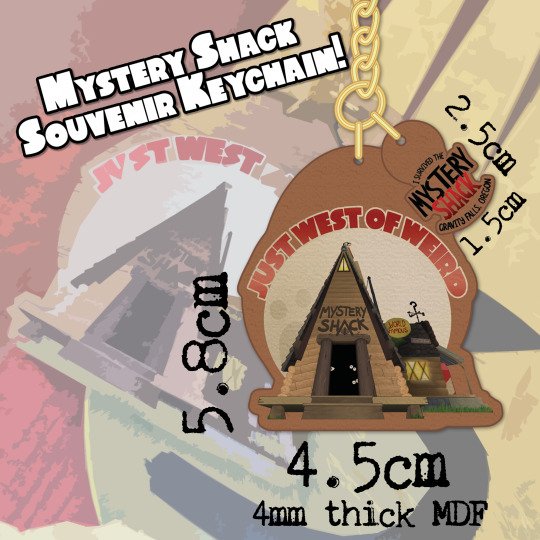

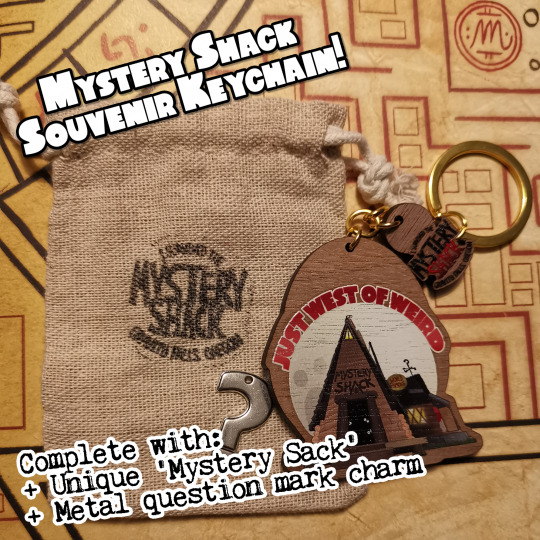
Gravity Falls: The Mystery Shack 'Just West of Weird' Wooden Keychain
A 5.8cm x 5.3cm wooden keyring, with golden keychain and Mystery Shack design - made of 4mm thick MDF with a walnut grain. Presented in a Mystery Shack 'smugglin' sack' with a question mark charm.
"Hey, you! Yeah, you! With the phone! Have you visited Gravity Falls and forgot your souvenir? Or do you just want to seem like one of the travelling elite that successfully breached its sacred halls? Don't worry, pal - Not S&P Approved has got you covered with this little beauty, straight from my gift shop.
This wooden keychain features a walnut grain with a detailed, full colour and part-glossed print - completed with a miniature logo charm, commemorating your absolutely real visit to a world-class tourist attraction in the American Northwest.
I've focused on makin' this thing sustainable, eco-friendly and chunky. It's a real fine piece of craftsmanship, and uses a brand new piece of art made especially for this product featuring my very own mansion of mystery. My hideaway of horrors! My definitely-not-a-cover-business-for-a-secret-interdimensional-portal! The Mystery Shack.
Coupled up with a gold chain - because who DOESN'T love a gold chain? - I'm content this is the classiest keyring on the planet. And the Grunkliest. Basically, the best one, and you should buy it!"
Shipped complete with a cotton Mystery Shack bag and a metal question mark charm!
Main keychain charm measures 5.8cm x 5.3cm
Logo charm measures 2.5cm by 1.5cm (yes, it's really that tiny!)
Matte print with gloss accents
Walnut-veneered MDF, sourced from fast-growing, sustainable forests.
Manufactured in the UK
AVAILABLE NOW
#gravity falls#gravity falls fandom#gravity falls fanart#gravity falls merch#wooden keychain#keyring#gravity falls merchandise#fan merch#etsy#etsyseller#etsyshop#not s&p approved#Mystery Shack#The Mystery Shack Souvenir#Gravity Falls Souvenir
34 notes
·
View notes